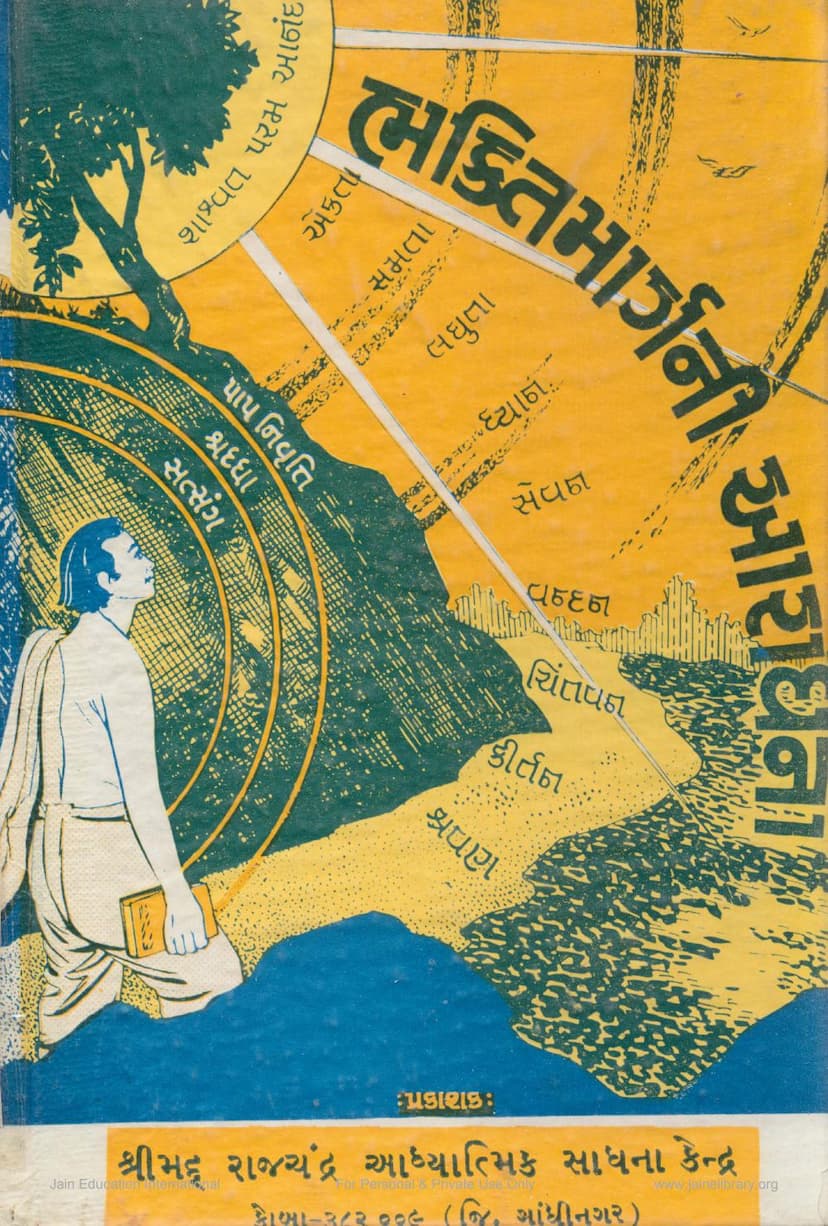Bhaktimarg Ni Aradhana
Added to library: September 1, 2025

Summary
Here's a comprehensive summary of the Jain text "Bhaktimarg ni Aradhana" by Atmanandji Maharaj, based on the provided pages:
Book Title: Bhaktimarg ni Aradhana (Worship on the Path of Devotion) Author: Pujya Shri Atmanandji Maharaj Publisher: Shrimad Rajchandra Sadhna Kendra Koba Catalog Link: https://jainqq.org/explore/005400/1
Overview:
"Bhaktimarg ni Aradhana" is a spiritual guide that explores the path of devotion (Bhakti Yoga) within the Jain tradition. Authored by Atmanandji Maharaj and published by Shrimad Rajchandra Sadhna Kendra, the book aims to provide a comprehensive understanding and practical guidance for devotees seeking spiritual growth through devotion. It emphasizes that while other paths like knowledge (Jnana Yoga) and meditation (Dhyana Yoga) exist, the path of devotion is presented as particularly accessible and effective in the current era.
Key Themes and Structure:
The book is structured into three main sections, each focusing on a crucial aspect of devotional practice:
-
Navadha Bhakti (Nine Types of Devotion): This section forms the core of the book, detailing the foundational elements and practices of devotion.
- Devotee and God: It begins by defining the nature of a devotee and the divine, including the qualities of a true devotee (discernment, selflessness, abandonment of physical sins, enthusiasm in devotional practices, cheerfulness, and practice of detachment) and the nature of God (Arhant, Acharya, virtuous scriptures).
- Forms of Devotion: It discusses various forms of devotion and their psychological underpinnings, explaining how they lead to purification of the mind and spiritual progress.
- The Ninefold Devotion: The book elaborates on the nine types of devotion:
- Shravana (Listening): Emphasizing the importance of listening to sermons, scriptures, and the virtuous deeds of enlightened beings to foster love and aspiration.
- Kirtana (Singing/Chanting): Describing the practice of singing praises and chanting the names of the divine and preceptors, often accompanied by music, to awaken devotion.
- Smaraṇa/Chintana (Remembrance/Contemplation): Focusing on contemplating the divine name, form, and virtues, leading to remembrance and internalization.
- Vandana/Sevana (Salutation/Service): Detailing the acts of worship, service, and bowing with reverence to the divine and spiritual guides, highlighting both external rituals and internal devotion.
- Dhyana (Meditation): Explaining the practice of deep concentration and meditation on the divine, leading to inner peace and spiritual realization.
- Laghuṭā (Humility/Supplication): Discussing the importance of humility, surrender, and sincere prayer, acknowledging one's limitations and seeking divine grace.
- Samata (Equanimity): Highlighting the development of equanimity and equal regard for all beings, seeing the divine essence in everyone.
- Ekata (Oneness): Describing the ultimate stage of devotion where the devotee experiences oneness with the divine, transcending the sense of duality.
-
Biographies of Saints and Great Souls: This section draws inspiration from the lives of eminent Jain saints and devotional figures. It presents their life stories, highlighting their exemplary devotion, spiritual achievements, and the impact they had on society and the Jain tradition. Notable figures discussed include:
- Acharya Samantabhadra Swami
- Acharya Siddhasena Divakara
- Mahakavi Maṇatuṅgāchārya
- Acharya Jinaseṇa
- Acharya Amitagati
- Acharya Hemachandra
- Mahakavi Ashadhara
- Sakalakirti
- Mahatma Kabir Das
- Bhaktakavi Narsinh Mehta
- Mirabai
- Anandghanji
- Ghanatrayji
- Shrimad Rajchandra
- Nanachandraji Maharaj
These biographies serve as practical examples, demonstrating how the principles of devotion can be lived and embodied.
-
Inspirational Verses, Chants, and Devotional Songs: This part of the book compiles various devotional songs, chants (dhun), and verses (padas) that can be used for personal and group worship. These are presented to aid in the purification of feelings (Bhavashuddhi) through devotional music and chanting, often with suggested meters and rhythms.
Methodology and Philosophy:
The book advocates for a devotional approach as the most effective means to achieve spiritual liberation in the Kali Yuga, given the rarity of fully realized gurus and the intellectual limitations of many individuals. The author argues that while the path of knowledge can be arduous and difficult to practice correctly in the present age, devotion is more accessible, straightforward, and conducive to spiritual welfare.
The author emphasizes:
- Simplicity and Accessibility: Devotion is presented as a path that doesn't require exceptional intellectual prowess or severe austerities, making it suitable for the common person.
- Emotional Engagement: The text highlights the role of divine love (prema) and emotional connection with God or the Guru as the driving force of devotion.
- Purification of Mind: Devotional practices are shown to cleanse the mind of negative qualities like ego, anger, and attachment, fostering virtues and inner peace.
- Role of True Gurus and Scriptures: The importance of seeking guidance from genuine spiritual teachers (Sadgurus) and adhering to authentic scriptures (Shuddha Dharmaprakaraka Shastras) is stressed.
- Integration of Devotion and Knowledge: While emphasizing devotion, the book does not negate the importance of knowledge. It suggests that devotion can lead to a state where knowledge becomes accessible and integrated.
- Importance of Bhavana (Feeling/Attitude): The true essence of devotion lies not just in outward rituals but in the inner feeling and attitude of love, surrender, and devotion.
Overall Message:
"Bhaktimarg ni Aradhana" serves as a comprehensive manual for spiritual seekers on the path of devotion. It aims to guide individuals towards self-purification, spiritual growth, and ultimately, liberation, by systematically explaining the principles, practices, and benefits of devotional worship, enriched by the inspiring lives of saints and a collection of devotional songs. The book encourages sincere practice and unwavering faith to attain the ultimate goal of spiritual realization.